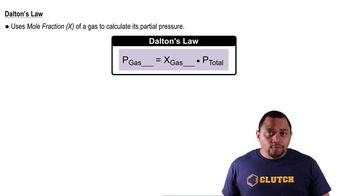A mixture of 14.2 g of H2 and 36.7 g of Ar is placed in a 100.0-L container at 290 K. (a) What is the partial pressure of H2 in atmospheres?
A sample of magnesium metal reacts with aqueous HCl to yield H2 gas: Mg1s2 + 2 HCl1aq2¡MgCl21aq2 + H21g2 The gas that forms is found to have a volume of 3.557 L at 25 °C and a pressure of 747 mm Hg. Assuming that the gas is saturated with water vapor at a partial pressure of 23.8 mm Hg, what is the partial pressure in millimeters of mercury of the H2? How many grams of magnesium metal were used in the reaction?
 Verified step by step guidance
Verified step by step guidance
Verified video answer for a similar problem:
Key Concepts
Ideal Gas Law

Dalton's Law of Partial Pressures

Stoichiometry

A mixture of 14.2 g of H2 and 36.7 g of Ar is placed in a 100.0-L container at 290 K. (b) What is the partial pressure of Ar in atmospheres?
Chlorine gas was first prepared in 1774 by the oxidation of NaCl with MnO2: 2 NaCl(s) + 2 H2SO4(l) + MnO2(s) → Na2SO4(s) + MnSO4(s) + 2 H2O(g) + Cl2(g) Assume that the gas produced is saturated with water vapor at a partial pressure of 28.7 mm Hg and that it has a volume of 0.597 L at 27 °C and 755 mm Hg pressure. (a) What is the mole fraction of Cl2 in the gas?
Chlorine gas was first prepared in 1774 by the oxidation of NaCl with MnO2: 2 NaCl(s) + 2 H2SO4(l) + MnO2(s) → Na2SO4(s) + MnSO4(s) + 2 H2O(g) + Cl2(g) Assume that the gas produced is saturated with water vapor at a partial pressure of 28.7 mm Hg and that it has a volume of 0.597 L at 27 °C and 755 mm Hg pressure. (b) How many grams of NaCl were used in the experiment, assuming complete reaction?
Natural gas is a mixture of hydrocarbons, primarily methane 1CH42 and ethane 1C2H62. A typical mixture might have Xmethane = 0.915 and Xethane = 0.085. Let's assume that we have a 15.50 g sample of natural gas in a volume of 15.00 L at a temperature of 20.00 °C. (a) How many total moles of gas are in the sample?
